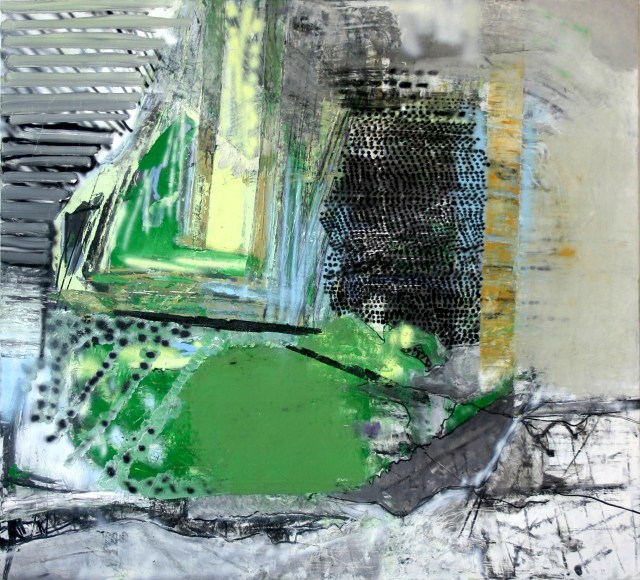
Root Division may have moved out of our long time location on 17th Street, but our artists will continue to have a presence in the neighborhood. Root Division’s Exhibitions and Events Director, Amy Cancelmo has been curating the lobby of our former neighbor, the ODC Theater with the work of our Studio Artists and Affiliates since 2011.
Currently on display is the work of Root Division Studio Artist, Josh Highter. Highter’s multi layered abstract paintings are inspired by the constant re-invention of the landscape–shaped by forces of society, economics, technology, and nature.
Josh Highter holds an MFA graduate of Indiana University, Bloomington, and is currently a lecturer teaching drawing and painting at UC Davis. Highter is an active part of the Root Division Studio Artist community and is currently teaching Introduction to Acrylic Painting in our Adult Education Program.
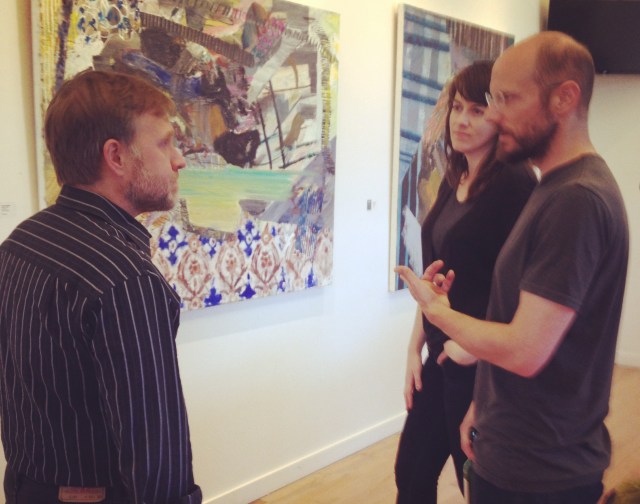
Amy Cancelmo: Josh, this is such a beautiful collection of your work– the paintings really look great in the space at ODC. Can you tell us a little bit about the inspiration for these pieces?
Josh Highter: I’m inspired by the landscape and how it is always in a constant state of change. With that as a general running narrative for the work, I’m also very interested in the process of painting and the various materials and applications within the tradition of painting.
AC: In our studio visit you mentioned to me that you began your painting career as a plein-air landscape artist. How do you think that plein-air painting has influenced your current practice, and how did you move from the observed landscape into the created, or composite landscape?
JH: Even though my current paintings are quite abstract in form, I truly see them as observational paintings and consider myself an observational painter. I have moved from the practice of working direct from the source to working in the studio, because I have become more interested in how we re-create spaces and places in our head and how we often carry around different ideas of landscape with us daily.
AC: You’re originally from Vermont, how has the shift in landscape, during your graduate program in Indiana, and now your time in the Bay Area affect your work?
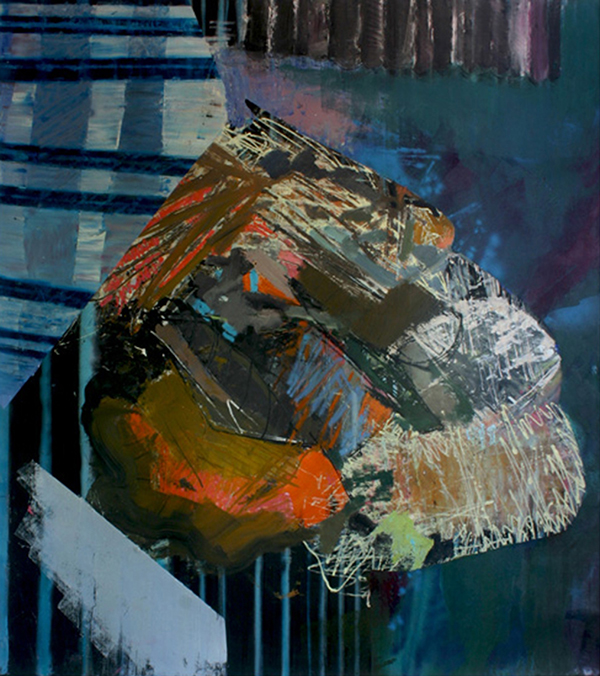
JH: I grew up as free-range kid in Vermont and was always outside, so the landscape has always been important to me. I went grad school at Indiana University in Bloomington and loved the painting program and people there, but did not find a real interest in the Indiana landscape. Through the process of looking for landscape motifs and other materials I could use as reference for my painting, I started collecting elements from the outside and started making set-up/maquettes to paint from in my studio. I think that this process of collecting and making is what my paintings are most about today, in that I’m interested in how we collect daily observations and re-assemble landscapes and places that we want to explore.
AC: Has Root Division’s new neighborhood influenced you at all?
JH: Yes, definitely. The idea of moving has reinforced my wanting the work to have accumulation of different spaces, which are both familiar and foreign or dislocated.
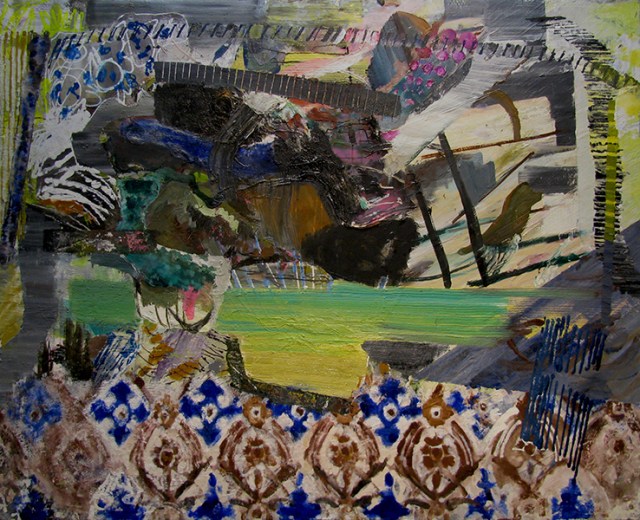
AC: Tell me a little bit about the source of some of these textural patterns in your work.
JH: I’m very interested in the way things work and how they’re put together. My paintings reference or are interpretations of the landscape, so patterns are reflective of things like the layering you get in geological processes or the building up that you might see in a mountain range or even a junk pile-there’s a sort of organic way these things happen. I also like experimenting with materials so I might make a repetitive pattern using a plastic sheet to stamp the canvas or syringes to make really fine lines. I like to experiment with how to make these things happen on a canvas.
AC: In addition to teaching in Root Division’s Adult Education Program, you’re currently teaching at Davis now, and to me your work seems very inspired by the work of the Bay Area Figurative Movement–Thiebaud’s abstracted landscapes of the Sacramento River Valley, Diebenkorn’s Berkeley series– many of the most prominent painters in that movement also taught at Davis. Are you inspired by these artists at all, and how do you see your work at Davis, if at all, in conversation with that history?
JH: I love these artists for their explorations of how to depict observation and for their explorations in different methods of painting. When I first started looking at Wayne Thiebaud’s paintings, what interested me was his ability to have multiple points of view with shifting vantage points in his work. This is something that still interests me today.
AC: What are you working on in your studio now?
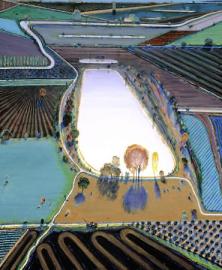
Ponds and Streams, 2001
IMAGE COURTESY OF FAMSF
JH: For the last year or so I’ve been really into making my own paint and really just exploring different ways to lay paint on a canvas. I’ve also been playing around with working in different mediums. This afternoon I’m actually making some monoprints. It’s a bit of an experiment because I can still play with the concepts of abstraction of space and landscape, but I can’t get the buildup of material that I’m used to. It’s fun because it makes me have to rethink how I’m going to make the forms that I want and it also helps me take a fresh look at how I make my paintings.
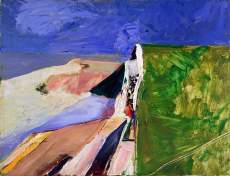
AC: The rich textures of your work are something that don’t necessarily read well in digital images, like on this blog- can you tell us a little bit about your painting style- I know you recently started making your own paints right?
JH: It does feel like my paintings are best seen in person-I really play with layering and building of paint in a way that’s a bit hard to read on a webpage. But that’s true for a lot of painters and artists. I think that people realize there is a qualitative difference in seeing a piece of art on a website vs in person.
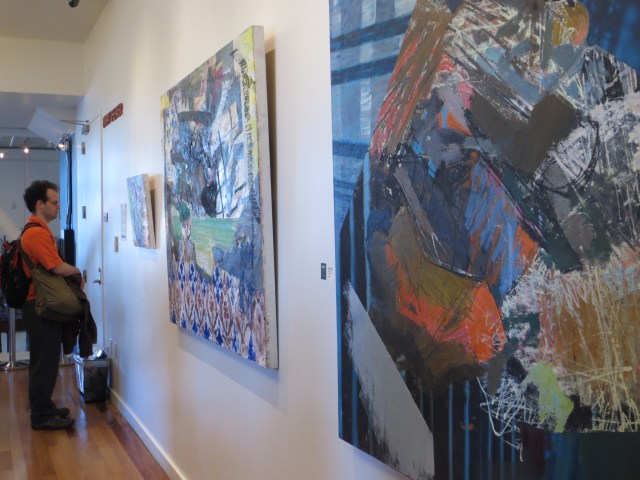
The show closes Monday, September 8th! Don’t miss seeing these great works in person! The ODC Theater is located at 31753 17th St. SF, CA 94110. There’s a great cafe in the lobby- have a scone, see some art, and say hello to the old neighborhood for us! AND COME VISIT US AT OUR NEW POP UP LOCATION ON MARKET ST 1059 Market St. (btwn. 6th & 7th!)
Josh Highter’s work will also be featured in Root Division’s 13th Annual Art Auction on October 23rd! Tickets are on sale now!
